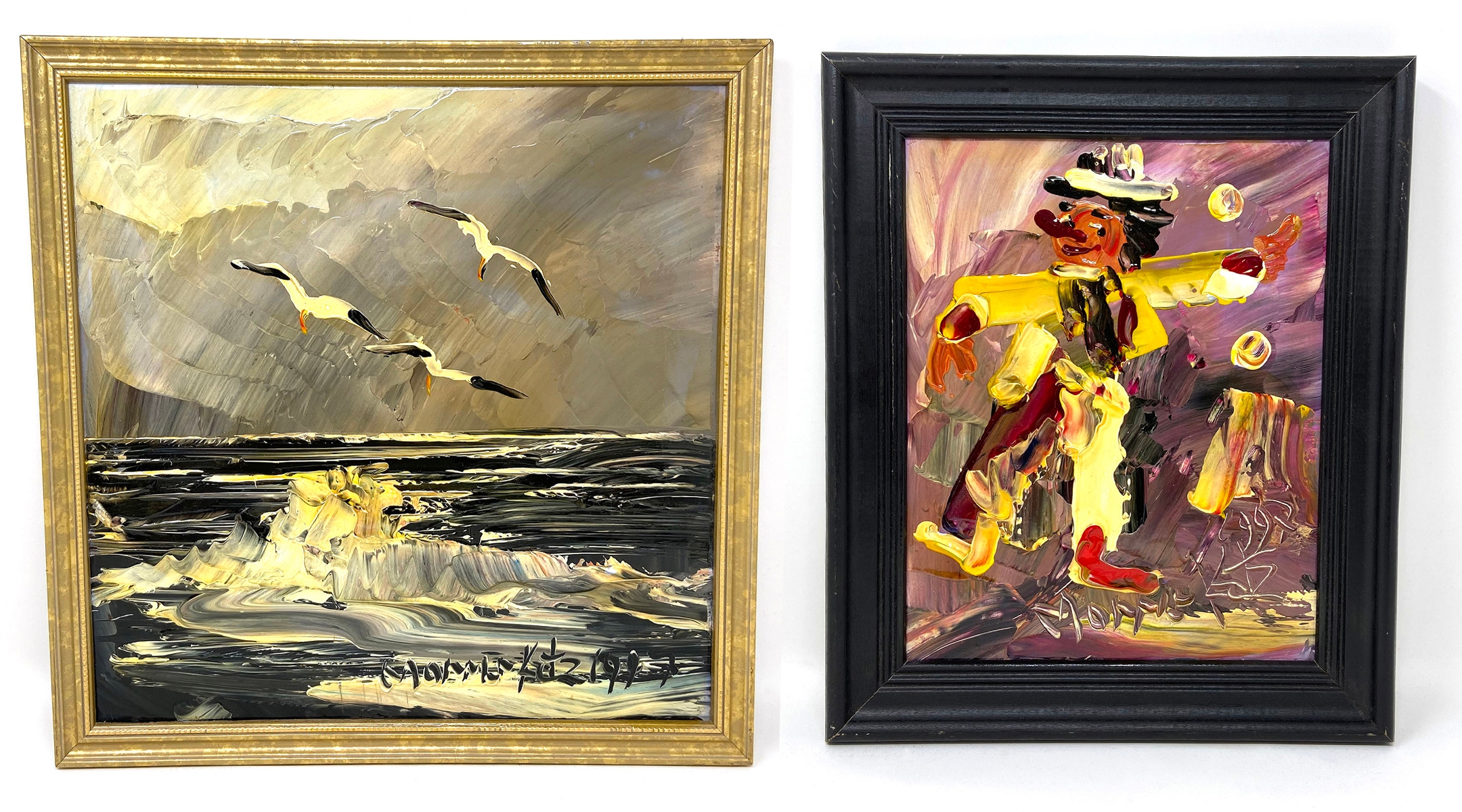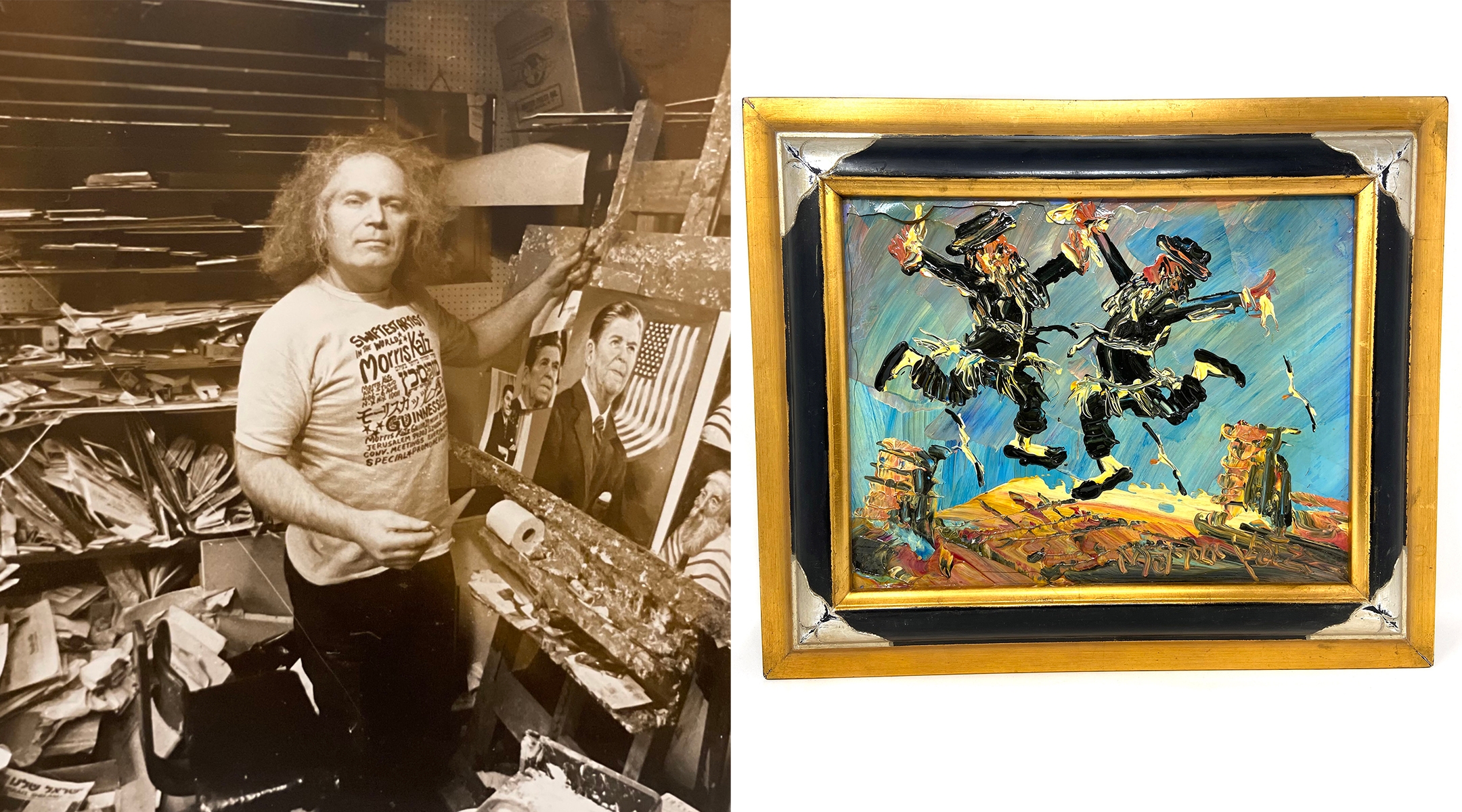(New York Jewish Week) – When the Catskills were king, Morris Katz was its court painter.
The heavily accented, Polish Holocaust survivor was a constant presence in the Jewish vacationland in upstate New York, offering a one-of-a-kind type of entertainment: speed-painting.
Appearing at Borscht Belt hotels like Grossinger’s, The Concord, Kutsher’s and Brown’s, Katz would whip up thousands of original paintings while his customers looked on. Landscapes, rabbis, clowns and animals would emerge in just a few minutes in a method he called “Instant Art.” While he painted, Katz bantered with the audience in Yiddish and English, telling jokes and talking about his life.
“He was like a strange, underground hero,” Eddy Portnoy, director of exhibitions at YIVO Institute for Jewish Research, told the New York Jewish Week. “He was just a really funny character. People found him to be really just kind of a joy.”
Before he died in 2010 at 78, Katz was recognized by the Guinness Book of World Records twice: First for being the most prolific painter in the world — over the course of his lifetime, Katz made anywhere from 200,000 to 300,000 paintings — and second for being the fastest painter in the world, having created a 12 x 16 painting in 30 seconds flat. Throughout his career, Katz won legions of fans, though he was never categorized a “real” artist by critics and by New York’s artist community, rather a distinct character with a specific skill.
But now, Portnoy has curated the first-ever solo gallery exhibition of his works. “The Instant Art of Morris Katz,” which features some 60 paintings in various sizes, along with a new exhibit about Katz’s life — from his childhood in Poland and in a displaced persons camp to to life as a peculiar celebrity — opens at YIVO at the Center for Jewish History (15 West 16th St.) on Thursday.
“Morris Katz never had a gallery exhibit in his lifetime, other than his own which was really just his workspace,” Portnoy said. “So this seems like a nice gesture to have a posthumous exhibit of his work.”
Portnoy started working on the exhibit last summer after he was connected with a donor who acquired approximately 10,000 Katz paintings in an estate sale. The donor, who requested to remain anonymous, told the New York Jewish Week that he remembers seeing Katz perform live while summering in the Catskills as a child. He bought the estate when he heard it was up for sale in 2011. “A lot of people from my era, people in their 60s and 70s and 80s, bought a painting in their day,” the donor said. “He was really a character and a known Borscht Belt entertainer.”
After a decade of holding on to the paintings, he was inspired to create an exhibit after learning there is a renewed interest in preserving Borscht Belt history through initiatives like the Borscht Belt Museum and the Borscht Belt Historical Markers Project. He is calling his haul the “Oeuvre Family Collection.”

Two examples of Katz’s “Instant Art” both painted in 1997. (Courtesy Oeuvre Family Collection)
The exhibit “reflects a moment in Jewish history where all kinds of unusual performers appeared in Borscht Belt hotels — it’s all sort of being forgotten,” Portnoy said. “This was a good opportunity to bring something like this back and jog peoples’ memories as to the kinds of things they saw in these places that were once such an important part of Jewish life.”
“It was a labor of love,” the donor said, adding that he’s happy to sell the paintings but would rather “get a bunch of people together and feel Jewish.”
“It doesn’t make a difference who comes — whether they’re Orthodox or Reform — a nice Jewish event in New York, just coming together, is a very important thing for us as a family and us as a people,” he said.
Born in Poland in 1932, Katz survived Nazi concentration camps, then arrived at a displaced persons camp in Germany at age 13. There, he learned to paint from a former teacher with the Warsaw Academy. He arrived in New York City in 1949 at age 17, where he studied art at the Art Students League before creating his “Instant Art” technique in 1956.
“He did it by dipping a palette knife into a bucket of paint, literally throwing the paint on the canvas, sort of squishing it around and then dabbing it with toilet paper to eventually create a kind of landscape or a scene or a character,” said Portnoy, who saw Katz’s act in Israel in 1989. “He was able to create paintings within just a couple of minutes.”
“Painting is like schmearing a bagel,” Katz is reported to have said.
Soon, Katz took his show on the road, where he successfully made a career off the shtick, painting landscapes, seascapes, city buildings, flowers, animals, rabbis, kids and clowns at high speeds at Borscht Belt hotels, conventions and fundraisers.
“He bantered with the audience, he told jokes. It was a Borscht Belt shtick,” Portnoy said In a JTA article about Katz from 1987, the painter describes himself as the “first kosher ham I ever met.”
“He’s down-to-earth,” David Boehm, editor of the Guinness Book of World Records, told JTA in 1987. “Katz claims art is experience. By hiding in haylofts and cellars he got the experience of danger … life and death. It makes him more down-to-earth in his work than if he had been living in an ivory tower.”
In his obituary, the New York Daily News recalled one of his mottos: “Paint it good, paint it fast and sell it cheap.”
Katz’s fans aren’t limited to those who were fortunate enough (or alive) to see him in person. Alex Weiser, 34, the director of public programs at YIVO, has a personal connection to the exhibit: He’s part of a younger generation that somewhat ironically, but still sentimentally, collects Katz paintings after having inherited them from an older relative.
“One of the things I like about his paintings is how textured they are with the kind of palette knife plus toilet paper technique. It’s just visually compelling,” he said. More than that, he loves knowing who it was painted by, and that it represents a fading era of Jewish history.
Weiser and his wife Stefanie Halpern, who also works at YIVO as the director of its archives, inherited their first Katz painting of a vase with flowers from Halpern’s grandmother several years ago. Now, Weiser has a Google alert set up for new Katz sales on eBay and peruses the site every morning. His criteria, he says, is “something I haven’t seen before” — Katz often painted similar landscapes, people and trees — or “Judaica within a reasonable price range.” So far, he’s collected more than half a dozen.
“When you look at one of these paintings, you see the story behind it,” Weiser said. “He was a painter for the people. He wasn’t this untouchable artist that nobody actually knows. He was connected to this whole era of Jewish history and so many people — including my grandmother-in-law — met him.”
For those wanting to start their own collection, YIVO is giving away Katz’s postcard-size paintings in exchange for a small donation at the exhibit opening on Thursday night.
“In a way, Katz is emblematic of a place like the Borscht Belt that was a really important cultural touchstone for a lot of Jews,” Weiser said. “That’s one of the things about Jewish history in general that I find amazing — there are these touchstones that bring the Jewish community together, despite all of the many things that otherwise divide us.”
“The Instant Art of Morris Katz” opens on Thursday May 16 at the YIVO Institute for Jewish Research (15 W. 16th Street). Register here for the free opening event on Thursday at 7 p.m., catered by the Challah Fairy.
The New York Jewish Week brings you the stories behind the headlines, keeping you connected to Jewish life in New York. Help sustain the reporting you trust by donating today.





